|
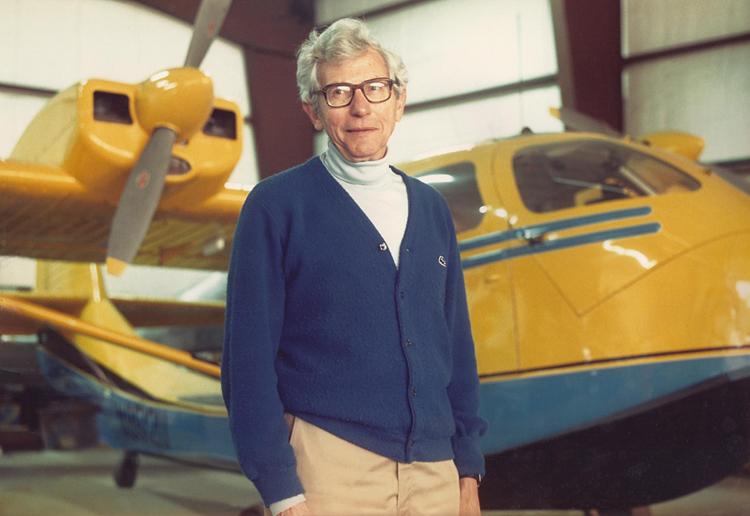
Joseph W. Gigante
1916 - 2012
|
|
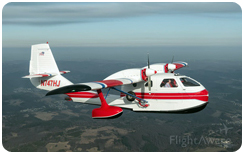 |
N747HJ (#024) Crashed
[2022-07-19] Sadly,
news reports confirm that Twin Bee #024,
N747HJ, crashed in Sweden yesterday - July 18, 2022. The Twin
Bee was flying water landing training on Lake Siljan, Dalarna,
when for unknown reasons the aircraft crashed and sank. The
Twin Bee had two German nationals on board. One person was
taken to hospital, but perished shortly after. The second
person is still missing at this date.
N747HJ is owned by Mr. Henner Jud, who had
#024 restored only a few years ago. The Twin Bee is normally
based at Siegerland Airport (SGE/EDGS), Germany, and arrived
Siljan Air Park (ESVS) in Sweden on July 10, where Mr. Jud has
spent his vacations for several years.
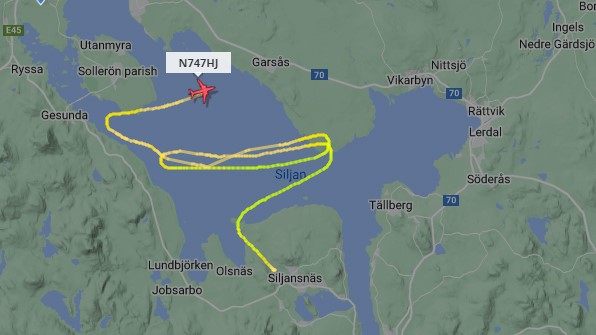
[2022-07-24] UPDATE
German news reports indicate the Twin Bee
N747HJ had been borrowed from owner by the young commercial
pilot Luca Born and his seaplane instructor for instruction flights at Lake Siljan. The
body of the second person
was recovered on Wednesday, 22 July.
22-year old Luca was an
avid pilot and aviation enthusiast from Hessen, Germany, who
had traveled to Sweden to explore his passion for seaplanes.
The identity of the instructor has not been made public.
|
|
|
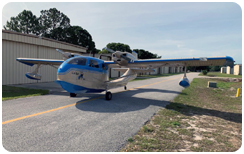 |
N25BY (#022) Restoration
[2021-01-16] Mark
Byrd reports that #022 has been restored. She looks great!
Mark spent 2½ years getting a total aircraft overhaul; engines,
propellers, paint, interior, all new cables, new landing gear, new
electrical system, removed vacuum system, new windows, new avionics and
flight instruments,2 JPI Engine Monitors, etc. New fuel system with 10+
hours of fuel.
N25BY is based at Winter Haven (KGIF), Florida. Nose art, "FatCat",
is from his dad's FatCat B-25 in WWII.
|
|
|
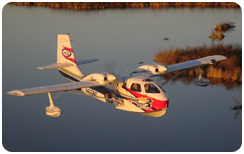 |
N65NE (#023) fatal crash
[2019-02-26] Sadly,
The Twin Bee Website have received several messages informing
that Twin Bee (#23),
N65NE, crashed in Florida, USA, on Saturday, February 23,
2019.
Awaiting first official NTSB Accident
Synopsis, news media report that the Twin Bee took off from
Winter Haven's Gilbert Airport (KGIF), Polk County, Florida,
for a training flight. At 12:45 PM, shortly after take off,
the aircraft apparently lost engine power and crashed into the
roof of a house on 2735 Idylridge Drive, just south of
airport. Photos suggest that the aircraft made an almost
vertical impact into the house.
Flight instructor James Wagner (64) was
killed. Student pilot Timothy Sheehy (33), from Montana,
survived with minor injuries. A young resident of the house,
Carmelle Ngalamulume (17), also suffered minor injuries.
More information will be published when
NTSB Preliminary Report is available.
NTSB Identification: ERA19FA106
On February 23, 2019, about 1243 eastern
standard time, a STOL Aircraft Corp UC-1 amphibious airplane,
N65NE, impacted a residence shortly after takeoff from Winter
Haven Regional Airport (GIF), Winter Haven, Florida. The
flight instructor was fatally injured, the commercial pilot
receiving instruction sustained minor injuries, and there was
one serious ground injury. The airplane was owned by ESP
Aviation LLC and privately operated under the provisions of 14
Code of Federal Regulations Part 91. Visual meteorological
conditions prevailed, and no flight plan was filed for the
local instructional flight which departed at 1239.
According to the commercial pilot receiving instruction (the
pilot), he and a colleague were receiving initial airplane
multiengine sea training from the flight instructor in the
accident airplane. The accident flight was the third flight of
the day.
According to the pilot, the instructor advised him before
takeoff that he would introduce a simulated engine failure at
some point during takeoff or climbout. Shortly after takeoff
from runway 23, about 200-300 ft above ground level (AGL), the
instructor reduced the throttle on the left engine and the
left engine stopped producing power, and the propeller
feathered. They identified the failed engine, the instructor
took over the flight controls, and selected a forced landing
site.
During the descent, the flight crew's engine restart
procedures were unsuccessful and they determined that the
airplane would not reach the selected forced landing site. The
instructor then chose a lake to the airplane's left as an
alternate site. During the left descending turn, the airplane
slowed, the left wing dropped, and the airplane impacted a
house, seriously injuring one of its occupants.
A witness in a fuel truck at GIF stated she watched the
airplane fly overhead. She saw both propellers rotating and
watched as the left propeller stopped rotating. The witness
said she then watched as the airplane "sank" in a
descending left turn until it disappeared from view.
The pilot held a commercial pilot certificate with ratings for
airplane single engine land, airplane single-engine sea, and
instrument airplane He held a flight instructor certificate
with a rating for airplane single-engine. His most recent FAA
second-class medical certificate was issued October 24, 2017.
He reported 820 total hours of flight experience on that date.
The flight instructor held an airline transport pilot
certificate with ratings for airplane single- and multiengine
land, and single- and multiengine sea. He held a flight
instructor certificate with ratings for airplane single- and
multiengine. His most recent FAA first-class medical
certificate was issued January 25, 2019. He reported 15,000
total hours of flight experience on that date.
The five-seat, twin-engine, high-wing, amphibious airplane was
manufactured in 1986. It was powered by two Lycoming IO-360,
180-horsepower engines, equipped with Hartzell two-blade,
constant-speed propellers. A review of the airplane
maintenance records revealed that a 100-hr inspection was
completed on February 23, 2019.
Examination of the accident site revealed that the airplane
came to rest inside the house and rested in a near vertical,
nose-down attitude. All major components were accounted for at
the scene. The cockpit area was destroyed and crushed inward.
The top of the fuselage between the engines was crushed
inward. The fuselage beyond the fifth seat was intact and
undamaged. The throttle quadrant, which ran along the top of
the cockpit, was separated during the impact sequence. The
wings remained attached and were removed for recovery. After
recovery of the airplane, control continuity was traced from
the cockpit, through several cable breaks to all flight
control surfaces.
The right-wing leading edge inboard of the engine was crushed
inward. The front and inboard side of the cowling was crushed.
The right-engine propeller blades displayed chordwise
scratching and tip curling. The wing outboard of the engine
was undamaged. The left-wing leading edge inbound of the
engine was crushed. The left propeller blades were feathered
and undamaged. There was damage to the outboard portion of the
wing, which included wrinkled skin, and upward folding of the
wing and skin. The wingtip was crushed inward.
The left and right engine crankshafts were rotated by hand at
the propeller hub, and continuity was confirmed through the
powertrain to the valve train and accessory section.
Compression was confirmed on all cylinders of both engines
using the thumb method. All of the ignition harness leads were
intact and undamaged. The right engine's magnetos were
manually rotated and produced spark at all terminal leads.
A test run of the left engine mounted on the left wing was
attempted. An external battery and engine controls were
connected, and an external fuel tank was plumbed directly to
the fuel pump inlet. The engine started immediately,
accelerated smoothly, and ran continuously at all selected
power settings without interruption.
No evidence of preimpact mechanical malfunction was noted
during the examination of the recovered airframe and engines.
At 1153, the weather conditions reported at GIF included, wind
from 170° at 12 knots, gusts to 17 knots, visibility 10
statute miles, few clouds at 3,400 ft, temperature 29° C, dew
point 20° C, and an altimeter setting of 30.15 inches of
mercury.
|
|
|
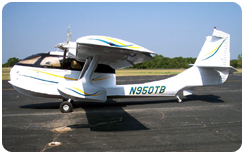 |
N950TB (#020) down
[2014-10-25] On October 25,
2014 Twin Bee N950TB (#020) was severely
damaged, when the pilot made an emergency landing on a field
near County Road 1314 near Farm to Market 768, about four
miles east of Cherokee County Airport (KJSO), Jacksonville,
Texas, after engine trouble on r/h engine.
According to a DPS report,
Mark Haag, 68, of Richmond was flying the aircraft from Reklaw
to the Cherokee County airport when he had to make an
emergency landing in a pasture just west of FM 768.
Two of his passengers, Susan
Inkley, 77, of Richmond and Bruce Finch, 84, of Houston, were
injured. Inkley was airlifted to a Tyler hospital and is
listed in good condition and Finch was taken to a Jacksonville
hospital.
Haag and another passenger,
Lisa Haag, 44, of Richmond, were not injured.
|
|
|
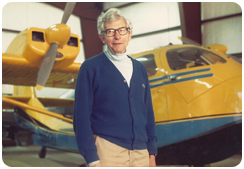 |
Joseph W. Gigante
[2012-04-16] Joseph
William Gigante, a resident of Westwood for over 60 years,
died Monday, April 9, 2012 at his home. He was 95.
Joseph was born December 2, 1916 in New York City, New York,
the son of Italian immigrants John and Anna (Gambardella)
Gigante. Joseph earned his bachelor’s degree in
aeronautical engineering from New York University. He
founded STOL Aircraft Corporation in Norwood, Massachusetts.
There he designed and produced the UC-1 Twin Bee amphibious
aircraft shown in the picture above, until his retirement in
1992.
Joe was an avid runner and
could often be found at the Westwood High School track.
He was the husband of the late Marianne (Ghysels) Gigante and
the brother of the late Mario, Victor, Alfred, and Aintonette
“Tina” Gigante. Joseph is survived by his daughter,
Nina C. Gigante of Venice, California; his two sons,
Stephen J. Gigante of New York City, New York, and David E.
Gigante of Lawrence, Kansas; his granddaughter, Eden Levin;
and two brothers, George Gigante of Van Nuys, California, and
John Gigante of Deerfield, Florida. Services and
interment will be private.
Mr. Gigante is truly one of the nicest persons I have ever had the pleasure of talking with! A few years ago we talked on the phone about his fantastic UC-1 Twin Bee amphibian. I had a "fearful" respect for this legend before calling him, but he
immediately made me feel like we had been friends all life! This is the first time I have seen a photo of Joe, and his charisma is evident! Every Twin Bee and Seabee fan will truly miss this great man. He will be remembered with appreciation. In deepest sympathy with all his family and
friends;
Steinar Saevdal
|
|
|
 |
MES Rating on Twin Bee!
[2011-01-21] Eric Weaver has
sent some quite amazing photos of N65NE (#23)
in Florida! N65NE is earning her keep at ESP Aviation,
where she is used for MES (Multi Engine Sea) rating new
seaplane pilots. They are located in Tavares, Florida,
and offer professional instruction, ground school on site,
in-flight training on N65NE, Commercial and Airline Transport
Pilot (ATP) - and of course great Florida weather!
For more information, and
your free "Twin Seabee Study Guide" and free
"Twin Bee Flight Manual" please visit:
www.mesrating.com
Thanks Eric for the amazing photos!
Please visit Photos section!
|
|
|
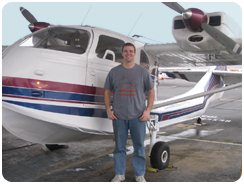 |
N9507U in Arizona
[2010-12-25] Ken Slough
kindly sent a few photos of Joe LaPlaca's Twin Bee N9705U in
Arizona! These are the first photos your webmaster has
seen of # 017!
Ken is the chief pilot of Island Airways in Charlevoix,
Michigan. He recently had the privilege of flying
LaPlaca's Twin Bee - I took an ATP ride in it and its a
great flying airplane!
Thanks Ken for your report
and the great photos!
|
|
|
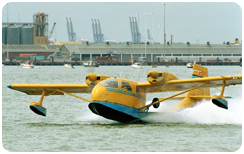 |
UC-1 Twin Bee Amphibian Design Rights for Sale!
[2006-09-20] Designer,
builder and owner of the UC-1 Twin Bee, Joseph Gigante,
president of the STOL Aircraft Corp., is announcing that he is
selling the FAA Type Certificate No. A6EA,
all design and production rights, documentation, tooling,
jigs, molds and parts for the unique UC-1 Twin Bee amphibian
aircraft.
The UC-1 Twin Bee, designed
by Mr. Gigante in the early 1960s, is a twin engine version of
the Republic RC-3 Seabee, remanufactured from components from
the single engine amphibian. First flight was made in
1960 and on June 25, 1965, FAA Type Certificate No. A6EA was
awarded. A total of 23 Twin Bees have been built to this date,
the last one in 1987.
The Twin Bee exhibits
exceptional short take-off and landing capabilities and has
proved to be the perfect personal yacht as well as one of the
most popular aircraft for multiengine seaplane ratings with
flight schools in the USA. Twin Bees are also flying in
Switzerland and in the Philippines.
This is a unique opportunity
to get an already FAA Type Certificated twin engine amphibian,
without spending millions to obtain design and approval.
In addition, Mr. Gigante is prepared to assist the new owner
of the Twin Bee to achieve production capability.
Mr. Gigante will consider
any reasonable offer from any party seriously interested
making the Twin Bee available for the market again.
For more details, please
contact Mr. Joseph Gigante at e-mail:

Serious inquiries only,
please!
|
|
|
|
Peter Annis
[2006-03-13] Peter Annis,
who was a test pilot for the UC-1 Twin Bees, kindly has sent a
lot of new information for the UC-1
Twin Bee Production List! Peter made the first
flight for all but one of the 23 Twin Bees built! He
also made the last flight for several of RC-3 Seabees that
were converted/remanufactured to UC-1 Twin Bees.
Hopefully, Peter will tell more about the Twin Bee history and
his experiences later...
|
|
|
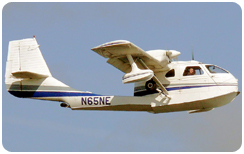 |
Ownership Changes
[2005-05-25] On
01 February 2005 Twin Bee N65NE (s/n 023) was registered on FAA Registry
to E S P Aviation LLC, Wilmington, Delaware, USA. N65NE was previously owned by Mr. Hardy F. LeBel who
sadly was killed in an airplane midair collision on 16 November 2003.
Mr. Daniel Staton of Corvallis, Oregon, informs that
he is the new owner of Twin Bee N950TB (s/n 020). N950TB is under
restoration, but has already made her first post-restoration
flights. This week # 020 will be flown to Oklahoma, where she will
get new paint, glass and interior. This final work is scheduled to be
finished late July. Daniel will send photos later.
|
|
|
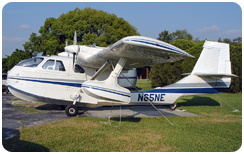 |
Twin Bee on eBay!
[2004-12-03] STOL
UC-1 Twin Bee N65NE (s/n 23) is currently listed for sale at eBay
auctions!
Go
to eBay!
Built in 1986, N65NE was the second to last Twin Bee
made. According to the eBay Auction description, she is in perfect
condition with a fresh annual of April 2004. TT 940 hours. The
eBay auction ends on 5 December. The Twin Bee auction has a
"Buy it Now" price of $ 175,000.
N65NE was previously owned by Mr. Hardy F. LeBel who
sadly was killed in an airplane midair collision on 16 November 2003.
|
|
|
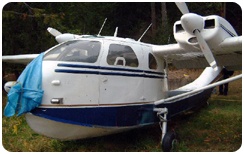 |
Twin Bees s/n 016
and s/n 020
[2004-04-26] Command
Aircraft Inc. of Bunnell, Florida, have acquired two UC-1 Twin Bee
amphibians; N950CB (s/n 016) and C-FLCL (s/n 020).
N950CB was acquired from an estate sale in New
Hampshire and was this April disassembled and moved to Florida.
N950CB is currently for sale! Please go to Seabee Classified
section for more details! N950CB will need assembly, a new annual
and replacement of fuel bladder, tires, brakes etc. as it has not flown
since 1991.
Last listed owner of N950CB was Mr. Thomas
F. Twomey; Chocorva, New Hampshire. Last listed owner of C-FLCL
was Mr. Johann
Olaf Baumgartner; Salt Spring Island, British
Columbia, Canada.
|
|
|
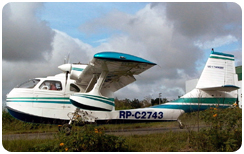 |
Twin Bee RP-C2743
Flying!
[2004-02-06] It
is with great joy Mr. Elpie Paras reports that his beautiful STOL UC-1
Twin Bee, RP-C27043 (s/n 015), successfully made her first test flight
in The Phillippines on 03 February 2004!
The test pilot was Capt. Leo D.
Yosalina, who is one of very
few amphibian rated CAA test pilots in The Philippines. Capt.
Yosalina reported no problems. Congratulations Elpie!
The test flight was made from Cagayan de Oro Airport
- Lumbia, CDO. Cagayan de Oro City has a population of more than 430 K,
and is located along the central coast of Northern Mindanao.
The city serves as the center of the Philippines'
administrative Region X, which includes the provinces of Camiguin,
Bukidnon, Misamis Oriental and Misamis Occidental.
RP-C2730 is ex N9506U, and was purchased by Elpie on
a government auction in 2000. More
photos.
|
|
|
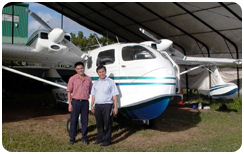 |
Philippine Photos
[2003-11-24] Mr. Elpie Paras has kindly sent several photos
of his beautiful Twin Bee (s/n 015) in The Philippines. That
paint scheme looks great!! Thank you Elpie!!
As can be seen from the photos, the Philippine
registration marks 'RP-C2743' have not been painted on the aircraft
yet. Some documents with Philippine
authority (ATO) have to
completed first. The Twin Bee is also awaiting her
first test flight for certification.
The only
qualified Filipino CAA test pilot is in the US for the time being.
RP-C2743 is ex American N9506U.
|
|
|
|
Hardy F. LeBel
[2003-11-19] It is sadly reported that Mr. Hardy Franklin LeBel
(65) was killed on Sunday, 16 November 2003, in a mid-air
collision between the Cessna 180 he was aboard and a Piper
PA-28-181. The tragic accident happened at Westerly State Airport,
Rhode Island. The other occupant of the Cessna 180 landplane, Mr.
Peter Budd Coleman (58), was also killed. The three persons aboard
the Piper PA-28 escaped without injuries. More details can be found at The
Westerly Sun Newspaper web-site. The accident is under
investigation by the local police and the NTSB.
Mr. LeBel was the owner of UC-1 Twin Bee N65NE, which
he purchased from Mr. Jay Merten early in 2002. He was a long time
commercial pilot/instructor and he was the Chief Pilot of New England
Air.
LeBel was an avid seaplane pilot, flying his Cessna
180 on amphibian floats and his new Twin Bee. LeBel was the Long
Island Field Director of SPA (Seaplane Pilots Association).
Updated 2003-11-24: From the NTSB Preliminary Accident Report, some more details on
the accidents;
On November 16, 2003, at 1330 eastern standard time,
a Cessna 180, N34AG, was substantially damaged when it impacted terrain,
after colliding in-flight with a Piper PA-28-181, N2885D. The Piper
received minor damage during a hard landing after the collision. The
collision occurred while the Cessna was taking off, and the Piper was
landing, at the Westerly Airport, Westerly, Rhode Island. Both
certificated flight instructors aboard the Cessna were fatally injured,
while the certificated private pilot and two passengers aboard the Piper
were not injured. Visual meteorological conditions prevailed, and no
flight plan was filed for either airplane. The Cessna was a local
instructional flight conducted under 14 CFR Part 91, while the Piper was
a personal flight conducted under 14 CFR Part 91, which originated from
the Windham Airport, Windham, Connecticut.
The complete Preliminary Accident Synopsis can be found at
the NTSB web-site. NTSB Identification: NYC04FA033A
.
|
|
|
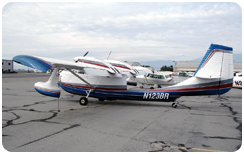 |
Twin Bee Photos
[2003-09-30] A Twin Bee owner sent a number of photos of beautiful
Twin Bee N123BR (s/n 012).
According to the US CAR, N123BR is currently owned by American
Aircraft Sales LLC; Wonewoc, Wisconsin, USA. However, it seems
that N123BR is operated by the company Flight Technologies, Inc.
For more Twin Bee photos, please visit
the Twin
Bee Photos section!
|
|
|
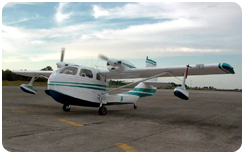 |
Twin Bee in The Philippines
[2003-09-30] Twin Bee s/n 015 (ex N9506U) was acquried by Mr. Elpidio
M. Paras, Cagayan de Oro City, The Philippines, on a government auction in
2000. After a three-year rebuild, #015 has now been registered as
"RP-C2743" on The Philippine CAR. The Philippine registration
marks have not been applied to the aircraft yet. More
photos...
|
|